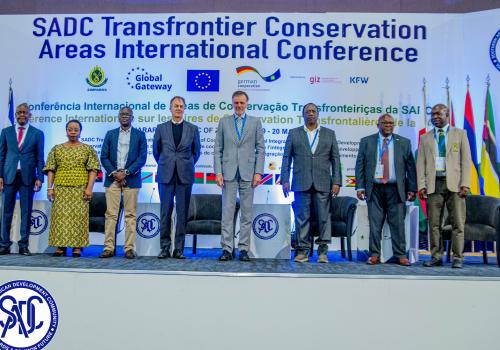The first ever Southern African Development Community (SADC) Transfrontier Conservation Areas (TFCA) Conference opened on 19 May 2025 at the Harare International Convention Centre in Zimbabwe under the theme: “SADC TFCAs: 25 Years of Cooperation for Regional Integration and Sustainable Development”.
The conference has drawn over 500 delegates and 30 exhibitors, including representatives from SADC Member States, International Cooperating Partners, Non-Governmental Organisations, Academia, Traditional and community leaders, and wildlife conservation experts. The conference is one of the precursors to the inaugural TFCA Summit of SADC Heads of State and Government, scheduled for 23rd May 2025, which will be chaired by His Excellency Dr. Emmerson Dambudzo Mnangagwa, President of the Republic of Zimbabwe in his capacity as the SADC Chairperson.
Ambassador Tadeous Chifamba, Permanent Secretary in the Ministry of Environment, Climate and Wildlife of the Republic of Zimbabwe, called for stronger cooperation and partnership among stakeholders in wildlife conservation to foster integrated and effective management of transboundary landscapes and seascapes, ensuring that they thrive for generations to come.
“As we celebrate 25 years of the SADC TFCA programme, we must also focus on enhancing local community engagement and beneficiation. There can be no conservation without local communities who since time immemorial have lived and carefully conserved the natural resources that we so dearly enjoy today”, said Ambassador Chifamba.
The Permanent Secretary who is also the Chairperson of Senior Officials for Committee for Environment, Natural Resources and Tourism, called on the conference delegates to consider innovative ways of ensuring communities are well capacitated, supported and directly benefit from the TFCA programme, including finding ways of addressing Human-Wildlife Conflict.
Head of Cooperation of the European Union Delegation to the Republic of Zimbabwe, Franck Porte hailed the TFCA Conference as a significant milestone in the SADC regional conservation efforts, emphasising that cross-border conservation initiatives are vital for safeguarding the planet’s rich natural heritage while driving regional integration.
He highlighted the EU’s support for TFCAs through the Global Gateway flagship initiative called NaturAfrica, which focuses on three pillars of Biodiversity Conservation, Green Economy and Governance and Partnerships, each essential to building resilient, inclusive and sustainable ecosystems.
On his part, His Excellency Udo Volz, Ambassador of the Federal Republic of Germany to the Republic of Zimbabwe, highlighted that the progress made in the SADC region in establishing and developing TFCAs is a prime example to the rest of the world, contributing significantly to the 30 by 30 target of the Global Biodiversity Framework which calls for 30% of the earth’s land and sea to be conserved through the establishment of protected areas and other area-based conservation measures.
The Country Director of the World Wide Fund for Nature (WWF) for Zimbabwe, Mr. Itai Chibaya said TFCAs are no longer just conservation zones, but corridors of connectivity, linking nations, cultures, ecosystems, and economies.
Mr. Itai Chibaya said: “Today, the SADC region leads the world in demonstrating that when Africa unites for nature, prosperity follows. TFCAs exemplify regional integration in action—not only in conference halls, but in the savannahs and forests where real people live, herd, farm, and thrive”.
Mr. Domingos Gove, Director of Food Agriculture and Natural Resources at the SADC Secretariat, highlighted the historical development of TFCAs started in 2019 with the first SADC TFCA, the Kgalagadi TFCA between Botswana and South Africa. Since then, SADC Region has established 13 TFCAs namely:
Lubombo TFCA comprising Eswatini, Mozambique and South Africa),
Ponta de Ouro-Ismangaliso TFCA;
Maloti-Drankesberg between Lesotho and South Africa,
Chimanimani TFCA between Mozambique and Zimbabwe,
Great Limpopo TFCA covering Mozambique, South Africa and Zimbabwe,
Ai/Ais-Richtersveld TFCA between Namibia and South Africa,
Greater Mapungubwe TFCA between South Africa and Zimbabwe,
KAZA covering Angola, Botswana, Namibia, Zambia and Zimbabwe,
Malawi–Zambia TFCA between Malawi and Zambia,
Niassa–Selous TFCA between Mozambique and the United Republic of Tanzania,
Iona–Skeleton Coast between Angola and Namibia,
Lower Zambezi–Mana Pools between Zambia and Zimbabwe, and
ZIMOZA TFCA covering Mozambique, Zambia and Zimbabwe.
The TFCA Conference is being hosted by the Government of Zimbabwe through the Ministry of Environment, Climate and Wildlife with support from the European Union and the Federal Republic of Germany through GIZ and KfW. Other partners that have provided financial and technical support include ZimParks, the International Union for Conservation of Nature (IUCN), Peace Parks Foundation, Conservation International, World Wide Fund for Nature (WWF), International Fund for Animal Welfare (IFAW), Frankfurt Zoological Society and Gonarezhou National Park.

